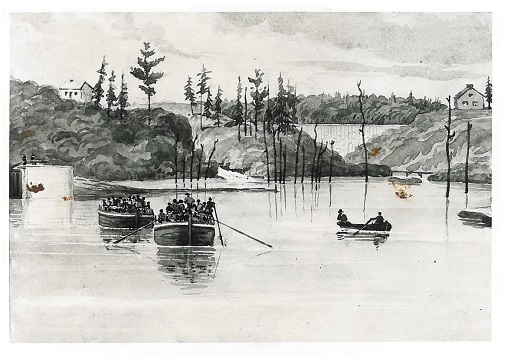History of Jones Falls lockstation
Rideau Canal National Historic Site

Specifications of the lockstation
Four locks (3 in flight, 1 detached) with a combined lift of 17.4 m (57.1 feet).
The Jones Falls lockstation is located between Whitefish and Sand Lakes within the Cataraqui Watershed. Like most of the lockstations between Kingston Mills and the Narrows, Jones Falls was built on the Frontenac Axis, an area where Precambrian rocks of the Canadian Shield extends south toward the Adirondack Mountains.
The Construction of the lockstation
The contractor for this job was a partnership of Thomas McKay and John Redpath and it was Redpath of whom completed the work on this site.
The construction of the Jones Falls lockstation in this rugged terrain is one of the most impressive feats of the canal builders. The contractor for this job was a partnership of Thomas McKay and John Redpath. It was John Redpath who did the work on this site. The contractor John Redpath, were faced with overcoming a series of rapids 1.6 km (1 mile) long with a fall of 18 m (60 feet). Work at Jones Falls began in 1827 and was completed in 1832. Colonel By's Clerk of Works, John MacTaggart, suggested a number of schemes to overcome the fall at Jones Falls but Colonel By developed a plan bolder than anyone had imagined. His design included a stone arch dam 18 m (60 feet) high and 107 m (350 feet) in length and four locks, each with a lift of 4.6m (15 feet). The upper lock and the flight of three lower locks are separated by a turning basin.
Structures of the lockstation
Defensible Lockmaster's House: This defensible structure was built on a hill above the upper lock, providing a clear view of both the upper and lower reaches. Built in 1840, its purpose was to protect the lockstation from attack as well as to provide accommodation for the lockmaster.
The house was used by the lockmaster well into the 20th century with little alteration to its original appearance. A small kitchen wing and porches were added but have since been removed.
Blacksmith's Shop: Located on the west bank of the station, just below the upper lock, this stone shop was built in 1843 to house a forge devoted to repairing the iron canal works. Jones Falls was a relatively remote location, and without a blacksmith shop on site, repairs to gates and other canal structures would have taken weeks. It was restored in 1978-79.
Former Guardhouse: The guardhouse, located on a height of land to the east side of the third lock, was constructed in1838 in response to the Upper Canada Rebellion of 1837. 6 m (20 feet)The guardhouse doubled as lodging for lock labourers. It fell into disrepair and was demolished in 1939.
Lock Office and Storage Building: These two buildings, constructed in the 20th century, are of frame construction and represent the commercial phase of the canal.
Generating Station: Unlike other lockstations that were built at the site of a pre-canal mill, the water power at Jones Falls was never harnessed for use by a mill. In the 1940s, a power generating station was built. This station, now owned by Portage Power, is one of four such plants along the Canal. The other three are located at Kingston Mills, Upper Brewers and Lower Brewers.
Dams: The locks and dam were built of sandstone blocks from the Elgin quarry. When it was built, the large arch stone dam, 18 m (60 feet) high and 107 m (350 feet) in length along the top, was the highest arch dam in North America. It is one of the most impressive engineering works on the canal.
A weir channel was blasted through a bedrock ridge between the dam and the upper lock. A wooden weir was installed to regulate the water level above the lockstation (Sand Lake). The weir was last reconstructed (cement) in 2011.
In the basin between the upper lock and the three lower locks, the clay and gravel dam at the exit was replaced by a concrete one in 1905-06. A sluice was installed in the dam to regulate the level of water in the basin.
- Date modified :